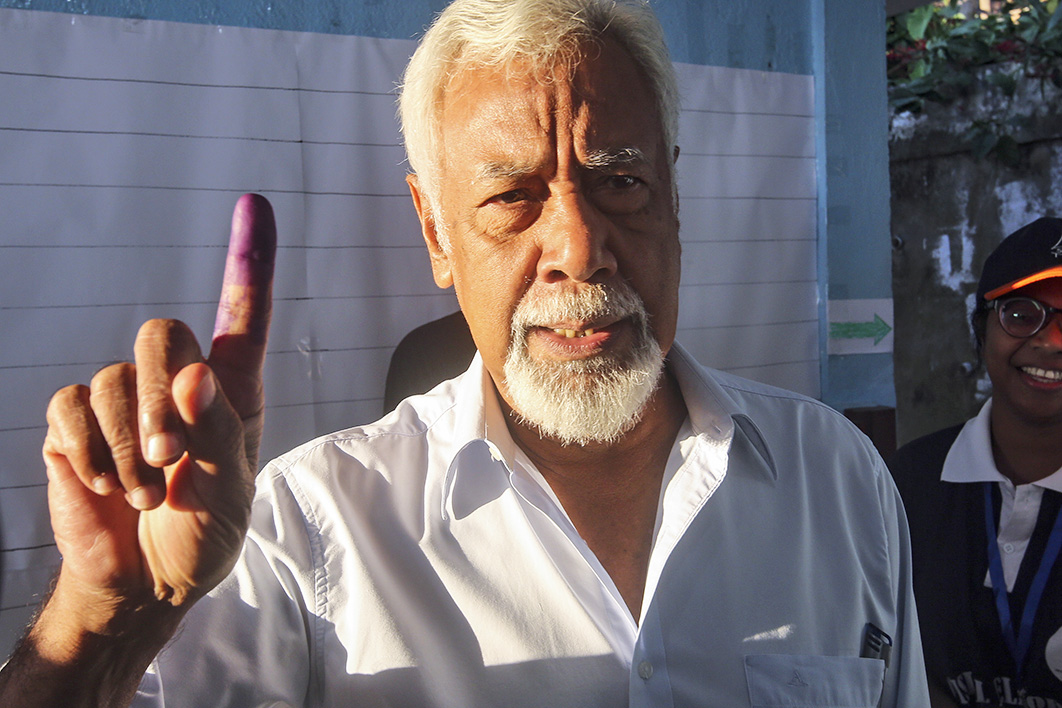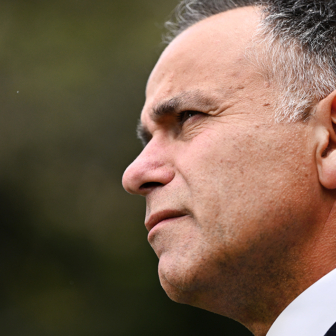Timor-Leste’s 890,000 voters went to the polls on Sunday in parliamentary elections that will determine the new government. The vote came at the end of a remarkably calm thirty-day campaign, with many locals commenting on the contrast with the political tensions of the past few years.
The poll was held on a Sunday to avoid a clash with the anniversary on Saturday of the restoration of Timor-Leste’s independence in 2002. Twenty-one years on and the young country has established itself as among the most democratic in Southeast Asia, with a Press Freedom Index score higher than Australia’s.
As part of the celebrations, president José Ramos-Horta presented Timor-Leste’s highest award, the Ordem de Timor-Leste, to Canberra lawyer Bernard Collaery. Collaery was making his first overseas trip since his passport was confiscated by the Australian government over charges, recently dropped, that he and his client — a former ASIS agent known as Witness K — had conspired to reveal Australian bugging of the Timorese cabinet during sensitive oil and gas treaty negotiations in 2004.
Witness K’s allegations eventually led to Timor-Leste’s successful challenge to the oil and gas treaty and, in 2018, the creation of a median-line maritime boundary with Australia. Bilateral relations have been on a much better footing since then, and Collaery received a hero’s welcome at Dili airport on arrival.
Saturday’s other high-profile recipients included former Victorian premier Steve Bracks, who has served as a high-level adviser to Xanana Gusmão on government reform since 2007. Also recognised were long-term solidarity activists John Waddingham and Cecily Gilbert, key among the small number of activists who have supported Timor-Leste since 1974–75. The pair now work with the Clearing House for Archival Records on Timor to preserve documents from the independence campaign and members of the East Timorese diaspora who lived in Australia.
With some 85 per cent of the national vote counted by Monday night, Xanana Gusmão’s CNRT party is clearly heading back to government after securing a resounding 41 per cent of the vote and a clear lead over its chief rival Fretilin, presently on 26 per cent.
Despite its hopes for a majority in its own right, and despite a major swing in its favour, the CNRT seems likely to fall just short of a thirty-three-seat majority. If that happens, a coalition with the Democratic Party, performing well at around 9 per cent, is firming as a likely outcome, pending the ongoing count, inter-party negotiations and the approval of the president.
Notably, the two parties associated with the worrisome martial arts gangs, or MAGs, performed relatively strongly, receiving around 11 per cent of the vote. This represents a sizeable constituency, and highlights the uncomfortable level of disaffection with conventional party politics among younger voters and their concerns about national economic performance and job opportunities.
Despite Ramos-Horta’s repeated warning that he would not look favourably on any coalition relying on either KHUNTO or the new party, Os Verdes (the Greens), these two MAG-linked parties appear to have attracted one-in-nine voters. With more than 7 per cent of the vote, KHUNTO is set to easily clear the 4 per cent hurdle for seats, though Os Verdes seems likely to fall just short.
As the vote progressed, it became clear that Fretilin would suffer the first notable drop in its vote since 2007, down some 4 per cent on its usual vote share. This will concern the long-established party, still recovering from the leadership tensions during last year’s presidential campaign, which saw the former army commander Lere Anan Timur run against the official Fretilin candidate, former president Francisco “Lú-Olo” Guterres. Despite a smoothing over of the rift, the Fretilin vote was contained by grassroots campaigning by Gusmão, who capitalised on his time in opposition to build the CNRT party structure and support across the country.
As Timor emerges from a difficult few years — Covid-19, floods and associated economic contraction — voters have once again turned to the “old firm” of Gusmão and Ramos-Horta, as they did after the 2006–07 political–military crisis. Voters might also have recognised that this could be the last election campaign fought by the two great national leaders, and sought to indicate trust in their ability to stimulate the economy and perhaps also respect for their longer-term achievements. As ever, election day itself went smoothly, with the usual friendly and efficient performance by the Technical Secretariat for Electoral Administration.
The new government is likely to proceed more aggressively with the Tasi Mane oil and gas megaproject, which will cast the spotlight again on commercial negotiations with Woodside, the project operator. Woodside is still sceptical about downstream processing on Timor-Leste’s south coast and, at this point anyway, agreeable only to co-investing in the upstream elements of the project.
Woodside’s hesitation raises questions about who would co-invest in the onshore components of the projects, and how much of Timor-Leste’s oil and gas petroleum fund of US$17 billion — on which annual budgets largely depend — would be spent on the daunting capital expenditure. With annual budgets exceeding interest from the fund, Timor-Leste faces a “fiscal cliff” within a decade if new revenues don’t flow in. Reaching a settlement over the future of the Greater Sunrise gas fields will bring new focus to the bilateral relationship with Australia, which has been at a high point in recent years. No less a figure than Steve Bracks — well linked to both the Australian government and Xanana Gusmão — has been asked to represent Australia in a current joint review process examining the feasibility of different downstream processing options.
In other respects, Sunday’s election may see some policy continuity in important areas. For example, the current government is extending the Bolsa da Mae program, which gives payments to mothers, to pregnant women and linking it to their attendance at health centres. CNRT policy suggests that any incoming Gusmão-led government will adopt this important program.
The wider significance of this election relates to the generational transition question. Gusmão’s victory comes as he approaches seventy-seven, with other key leaders not far behind. This raises the expectation that a political transition will take place during this term, though old Timor hands note that the transition isn’t likely to happen without active challenges from younger leaders. One key question still up in the air is the likely future leadership of non-Fretilin politics whenever Gusmão eventually departs the stage.
As a new government takes office, a critical decade for Timor-Leste’s future commences. The country still awaits economic diversification away from oil and gas dependence, and faces a major demographic “youth bulge.” In what will likely prove their farewell terms, members of the “old firm” now get to leave their legacy. How they do this will be watched closely at this critical juncture of Timor-Leste’s development. •




